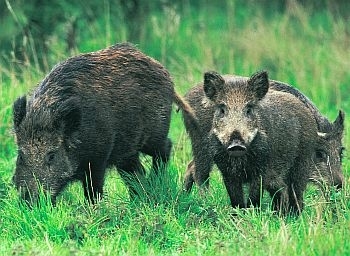Taxonomy: Class: Mammalia; Order: Artiodactyla; Family: Suidae
Description

Wild boar © Alexis de la Serre
The wild boar is an omnivorous mainly nocturnal animal closely related to the domestic pig. It was exterminated from the British Isles in medieval times. Wild boars were imported from the Continent for meat farming in the 1980s, and escaped animals established themselves in the wild in the early 1990s. On the Continent, wild boar cause significant damage to agriculture, and act as reservoirs for swine fever and other porcine diseases. The wild boar can be shot all year round, provided that it is listed on the fire-arms certificate.
Further information:
British Wild Boar website .
Conservation status and legislation
Status:
UK: Feral
World: Least Concern (IUCN Red List)
Legislation:
Distribution and abundance
There are several confirmed breeding populations of wild boar in the UK. In England they are established on the Kent/East Sussex border, in Dorset, in Devon and in Gloucestershire (Forest of Dean). Animals from the latter site have crossed into Wales and become established in Monmouthshire. Wild boars have also been seen in many other UK counties, though without proof of reproduction. Few of these records appear on the map.
Estimates of wild boar abundance (numbers of individuals in the spring) across the UK, from Battersby (2005):
Recent trends from the National Gamebag Census
Eight NGC sites have reported wild boar, beginning in 2000. Three of these are in Dorset, one in Kent, two in Suffolk, one in North Yorkshire and one in Aberdeenshire. There are too few bag records of wild boar to produce trend estimates.
Environmental zones
Five of the eight NGC sites that reported wild boar were in the Easterly Lowlands of England, two were in the Westerly Lowlands of England, and one in the Lowlands of Scotland. There are too few bag records of wild boar to produce trend estimates.
Comparison with BBS mammal data
No comparison is possible because there are too few records.
Long-term trend from the National Gamebag Census
The wild boar has been recorded in the NGC too late and too sparsely to evaluate long-term trend.
References and further reading
- Battersby,J. (2005). UK Mammals: Species Status and Population Trends. Joint Nature Conservation Committee/Tracking Mammals Partnership, Peterborough (JNCC download page).
- Harris,S. & Yalden,D.W. (2008). Mammals of the British Isles: Handbook, 4th edition. Mammal Society, Southampton.
- Wilson,C.J. (2003). Distribution and status of feral wild boar Sus scrofa in Dorset, southern England. Mammal Review 33: 302-307.
- Wilson,C.J. (2004). Rooting damage to farmland in Dorset, southern England, caused by feral wild boar Sus scrofa. Mammal Review 34: 331-335.
This report should be cited as: Aebischer,N.J., Davey,P.D. & Kingdon,N.G. (2011). National Gamebag Census: Mammal Trends to 2009. Game & Wildlife Conservation Trust, Fordingbridge (http://www.gwct.org.uk/ngcmammals).
Return to species list
Get the Latest News & Advice
Join over 100,000 subscribers and stay updated on our latest advice, research, news and offers.
*You may change your mind any time. For more information, see our Privacy Policy.